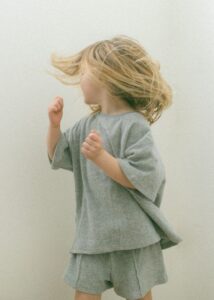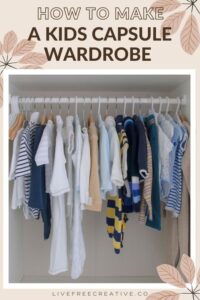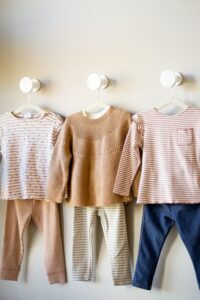Uncategorized
Exploring the Minimalist Approach in Kids’ Clothing
Minimalism is not just a design trend or an aesthetic—it’s a lifestyle choice that emphasizes simplicity, functionality, and sustainability. In the world of kids’ fashion, adopting a minimalist approach offers a range of benefits, from reducing clutter and waste to fostering independence and self-expression in children.
This guide explores how a minimalist approach can transform your child’s wardrobe into a practical, stylish, and eco-friendly collection while simplifying your life as a parent.
1. What Is Minimalism in Kids’ Clothing?
Minimalism in kids’ clothing focuses on creating a wardrobe with fewer, high-quality, versatile pieces that can be mixed and matched effortlessly. It prioritizes:
- Functionality: Clothes that serve multiple purposes and adapt to various occasions.
- Sustainability: Choosing eco-friendly fabrics and reducing waste.
- Timelessness: Neutral colors, classic designs, and durable materials that never go out of style.
By eliminating excess, minimalism helps parents invest in quality over quantity, simplifying decision-making and reducing clutter.
2. Benefits of a Minimalist Wardrobe for Kids
Adopting a minimalist approach to kids’ clothing comes with a host of benefits:
- Saves Time: With fewer items, getting your child dressed becomes quicker and less stressful.
- Encourages Independence: A simplified wardrobe allows kids to easily choose their own outfits.
- Reduces Clutter: Streamlining clothing reduces the amount of laundry, storage needs, and unnecessary purchases.
- Eco-Friendly: Fewer, high-quality items mean less textile waste and a smaller environmental footprint.
- Cost-Effective: Investing in durable, versatile pieces saves money in the long run by reducing the need for frequent replacements.
A minimalist wardrobe not only benefits parents but also teaches children valuable lessons about mindful consumption.
3. Key Principles of Minimalist Kids’ Clothing

To embrace minimalism in your child’s wardrobe, consider the following principles:
a. Prioritize Versatility
Choose clothing items that can be worn across different settings and seasons.
- Neutral colors like white, gray, navy, and beige pair well with everything.
- Simple designs without bold logos or patterns allow for easy mixing and matching.
- Layerable pieces like cardigans, leggings, and lightweight jackets adapt to changing weather.
b. Focus on Quality Over Quantity
Invest in durable, high-quality fabrics that withstand active play and frequent washing.
- Opt for organic cotton, bamboo, or other sustainable materials.
- Look for reinforced seams and double stitching for longevity.
- Choose timeless styles that don’t go out of fashion.
c. Keep It Simple
A minimalist wardrobe should have just the essentials.
- Examples of Essentials:
- 5-7 tops
- 3-4 bottoms
- 2-3 pairs of shoes
- Seasonal outerwear
- A mix of casual and formal pieces
By sticking to the basics, you avoid overloading your child’s wardrobe with unnecessary items.
4. How to Build a Minimalist Wardrobe for Kids
Creating a minimalist wardrobe for your child involves thoughtful planning and intentional shopping.
Step 1: Declutter
Start by assessing your child’s existing clothing.
- Sort items into categories: keep, donate, and repurpose.
- Eliminate clothes that are outgrown, stained, or rarely worn.
Decluttering provides a clean slate for building a purposeful wardrobe.
Step 2: Identify Needs
Determine what your child actually needs based on their daily activities, climate, and lifestyle.
- Do they need more play clothes or formal wear?
- Are there seasonal gaps, like a missing winter coat or rain boots?
Knowing your child’s needs helps avoid impulse buys.
Step 3: Shop Intentionally
When purchasing new items, focus on quality, versatility, and sustainability.
- Look for brands that prioritize ethical and eco-friendly practices.
- Avoid trendy or overly decorative pieces that may quickly go out of style.
- Buy only what is necessary to fill wardrobe gaps.
Shopping intentionally ensures that every piece in your child’s wardrobe serves a purpose.
Step 4: Organize and Maintain
Once you’ve curated the wardrobe, organize it for easy access.
- Use drawers, bins, or shelves to separate categories.
- Rotate seasonal items as needed.
- Regularly review and adjust the wardrobe as your child grows.
An organized wardrobe simplifies daily routines and ensures everything gets used.
5. Incorporating Minimalism for Different Ages

Minimalism looks slightly different depending on the age of the child.
Infants and Toddlers
- Prioritize comfort and ease of dressing.
- Choose onesies, rompers, and stretchy pants that are practical for diaper changes.
- Stick to soft, breathable fabrics suitable for sensitive skin.
Preschoolers
- Invest in durable clothes for active play.
- Include simple outfits they can put on themselves to encourage independence.
- Opt for machine-washable fabrics to handle spills and stains.
School-Age Children
- Focus on versatile pieces for school, playdates, and extracurricular activities.
- Allow them to help choose clothing to develop their sense of style.
- Include a mix of casual and slightly formal wear for special occasions.
Minimalism adapts to the changing needs of children as they grow.
6. Sustainable Kids’ Clothing Brands
Several brands align with the minimalist philosophy by offering sustainable, high-quality kids’ clothing:
- Primary: Known for simple, solid-color basics that are easy to mix and match.
- Hanna Andersson: Offers durable, eco-friendly clothing with classic designs.
- Mini Rodini: A high-end brand focusing on organic and recycled materials.
- Patagonia Kids: Provides sustainable outdoor and everyday clothing.
- Little Green Radicals: Specializes in organic, ethically made kids’ wear.
These brands support a minimalist lifestyle by providing durable and versatile options.
7. Overcoming Challenges in Minimalism for Kids
While minimalism has many advantages, it can come with challenges:
- Growth Spurts: Kids grow quickly, requiring regular updates to their wardrobes.
- Solution: Opt for adjustable features like elastic waistbands and size-up purchases.
- Peer Pressure: Older kids may feel the need to follow trends.
- Solution: Balance minimalist values with a few trendy pieces to let them express themselves.
- Laundry Cycles: Fewer clothes mean more frequent washing.
- Solution: Choose quick-drying fabrics and create a laundry routine to stay on top of things.
By addressing these challenges, minimalism becomes a practical and sustainable choice.
8. Minimalism as a Life Lesson

A minimalist wardrobe is not just about saving time and money—it’s also an opportunity to teach children valuable lessons:
- Mindful Consumption: Understanding the importance of buying only what is necessary.
- Environmental Awareness: Learning how sustainable choices can impact the planet.
- Appreciation for Quality: Valuing well-made items over disposable fashion.
These lessons help children develop thoughtful habits that extend beyond their wardrobe.
Conclusion
The minimalist approach to kids’ clothing simplifies life, saves money, and promotes sustainability. By focusing on quality, versatility, and timeless designs, parents can create a wardrobe that meets their child’s needs without excess.
At Regal XX Hue, we celebrate the principles of minimalism by offering a curated collection of stylish and durable kids’ clothing. Explore our range to build a thoughtful, minimalist wardrobe for your little one!


